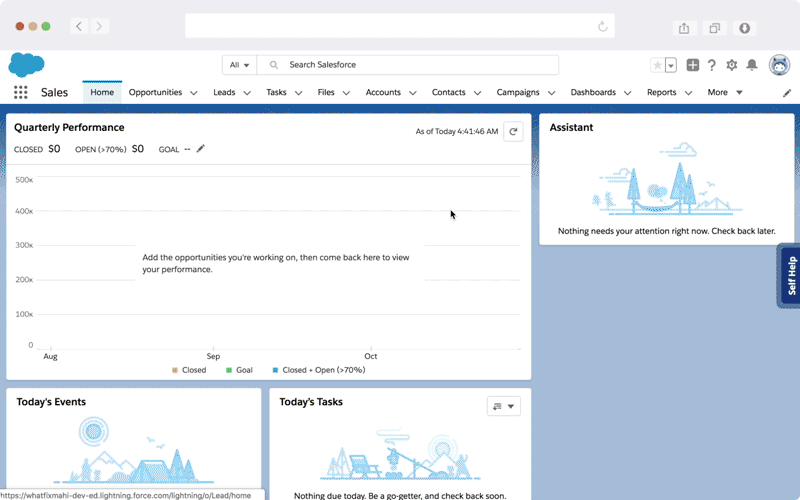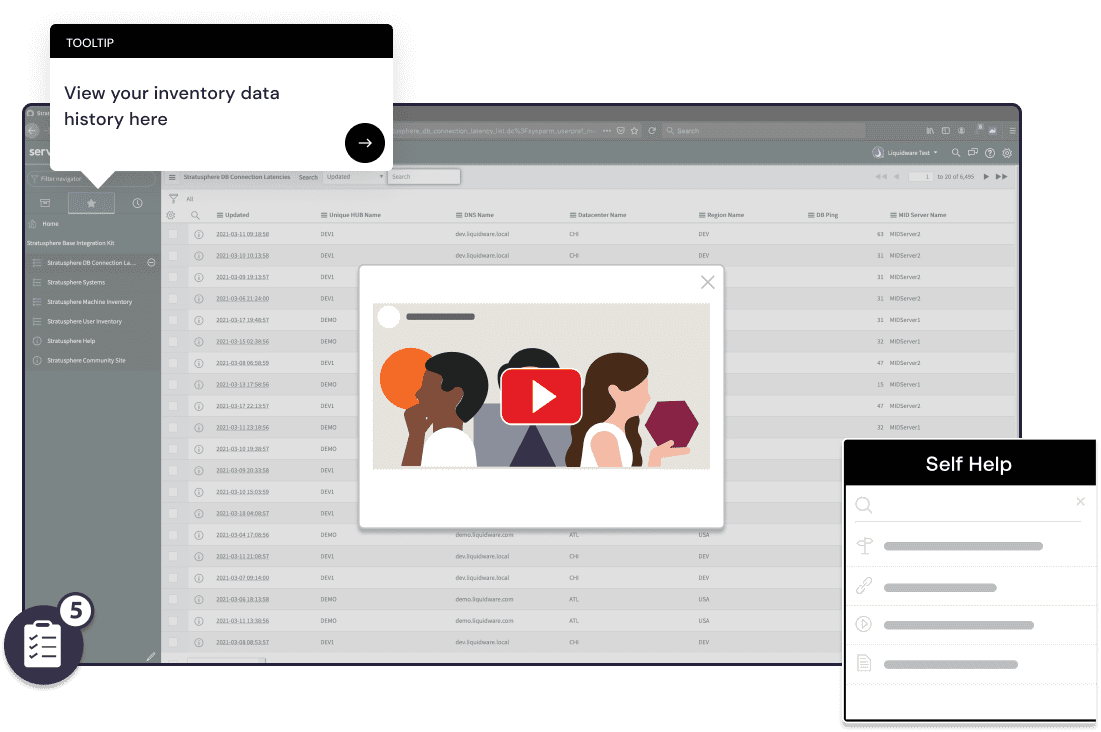Digital transformation has empowered organizations to become more automated, have more efficient workflows, and provide better customer experiences. ServiceNow is one of the most widely used cloud-based systems that helps enterprise businesses modernize with features such as automation, machine learning, artificial intelligence, and more.
What Is ServiceNow?
ServiceNow is a cloud-based software platform that has the features to combine IT operations, HR service, security systems, IT business management, and customer services into one single system of record. The platform is based on ITIL guidelines to provide service orientation for tasks, activities, and processes. It uses machine learning to leverage data and workflows and offers the flexibility, power, and dependability to achieve incident and problem management goals.
Best ServiceNow Training Delivery Methods in the Workplace
We’ve put together seven of the top ServiceNow training delivery methods for you to implement to get the most out of your investment.
1. Now Learning Platform
Who better to teach your employees to use the platform than someone specifically certified to do so? ServiceNow offers live, instructor-led classes, and hands-on labs, which you can sign up for via the Now Learning platform. It allows you to get insights on specific ServiceNow applications and concepts such as ITOM (IT Operations Management), CMDB (Configuration Management Database), and GRC (Governance, Risk, and Compliance).

The courses run for multiple days and ensure trainees get an in-depth understanding of every concept via online classes, which include a combination of lectures, group discussions, and hands-on work on the platform.
2. ServiceNow Docs
Another learning resource that ServiceNow provides is ServiceNow Docs. This site hosts the product documentation for all features of the platform. Once an employee finds the feature they’re interested in, they can see a breakdown, including how to use it and how it can benefit the company. The feature pages also have video demos to show best practices.

ServiceNow Docs also makes it easy to stay up-to-date on all aspects of the platform your company uses. The pages have release notes, a PDF library, product accessibility, and information about upgrades.
3. Digital Adoption Platform
One of the best ways to get familiar with a platform is to actually use it. By implementing a digital adoption platform like Whatfix, you can provide trainees with step-by-step guidance on the ServiceNow platform. The platform enables learning while doing, where employees can train and practice using the platform simultaneously.
Whatfix guided walkthroughs take employees through each step of different processes or features on the platform, ensuring they complete their tasks successfully.
The three most commonly used types of ServiceNow training in Whatfix are:
1. Product tours: When employees first begin to use the platform, Whatfix greets them with a product tour pop-up that, once clicked, initializes a walkthrough of all the major touchpoints of your customized ServiceNow software.

2. Task lists: The task list allows managers to create a list of to-do tasks for every employee to help them kickstart the software onboarding process. The task list engages and reminds users to complete the tasks at hand by enabling them to self-track their individual progress against their assigned tasks.

3. Self-help menus: Self-help menus offer instant access to walkthroughs, videos, and knowledge base articles for the users to proactively complete tasks without any external support. The menus update as the employees move through the platform, so the first results are always relevant to the feature they are currently using.
By providing in-app guidance, DAPs ensure that your employees can take full advantage of your new ServiceNow implementation without spending hours and hours in training before practicing on the platform.
4. Learning Management System
Another option for in-house ServiceNow training is implementing a learning management system (LMS). LMS such as Adobe Captivate Prime or 360Learning offer a central location to create and organize training courses. An LMS typically includes both passive and active training materials, ranging from reading materials to slideshows to discussion forums, so there is something to help every employee regardless of their learning style. Since team members can easily access and find training as needed, an LMS enables self-paced learning.
Furthermore, you can tailor the material in your LMS to make it more relevant to the way your employees actually use the ServiceNow platform. Managers can also track the progress of their team through LMS and test them at regular intervals to ensure they are absorbing what they learn.
5. ServiceNow Community
Another way to supplement a formal ServiceNow training course is by participating in the ServieNow community and engaging with others using the platform. The community page is divided into topic-based forums for asking questions and finding solutions to common problems. Even if you don’t have specific questions, you can learn the best practices and get advice from other ServiceNow users, as well as get information about new releases and updates.

ServiceNow also posts webinars on the site and hosts “ask the experts” forums. All of these resources help enhance your employees’ corporate training on the platform and keep your team informed and up-to-date.
6. Third-party Learning
If you’re looking for a ServiceNow training option that requires less scheduling, you can find on-demand courses through third parties such as Udemy. This type of ServiceNow certification training allows employees to learn in their own time without having to coordinate with live instructors.
ServiceNow certification training offers standalone lessons that each cover a different aspect of the platform. Some are single lessons, while others have multiple modules. Many of the lessons are free. The Advanced Work Assignment course, for example, is free and consists of three related modules.

Third-party providers have an array of lessons with lectures and training covering different aspects of the ServiceNow platform. Typically, there are fees for these courses. On Udemy, for example, the ServiceNow training course range from under $20 USD to over $100 USD for a multi-hour module.
7. Video Tutorials
Training is an ongoing process, so it’s useful to give your employees resources for learning as they go. ServiceNow has a YouTube channel with training videos and guided best practices for using the platform. The videos are easily accessible on-demand, so your team can watch them whenever they get stuck on a certain part of the platform.

While these videos won’t cover everything that formal training courses will, they are a useful supplemental tool. Employees can look up videos specific to the feature they need more help with, without having to sort through a multi-hour training course for the right piece of information.
This also means managers won’t have to constantly answer employee questions about using the platform, so they will have more time for other tasks.
Related Resources
Why Should Employees Consider Pursuing ServiceNow Training and Certification
Here are a few reasons for working professionals to pursue ServiceNow training.
1. In-Demand Skills
The world is going digital, and companies are running more and more applications on the cloud. To keep up with the competition, it’s essential that you have the skills to use the latest technology. Having in-demand ServiceNow skills enable you to utilize the full potential of the ServiceNow platform.
By acquiring a certification, you can deliver smoother deployments, spend less time troubleshooting, and create efficient, reliable, and scalable solutions helping your organization effectively innovate with ServiceNow.
2. Job Satisfaction
Becoming proficient in an in-demand skill like ServiceNow can help you attain both personal and job satisfaction, as it will have a positive impact on your career in terms of getting promotions and good compensation.
3. Better Performance in the Workplace
ServiceNow training helps you get a hands-on understanding of the platform, ensuring proficiency, productivity, and efficiency to improve your overall performance in the workplace.
4. Professional Advancement
ServiceNow is gaining momentum and is growing very fast with its high acceptance rate, making it a stable career choice. Getting ServiceNow training will offer you the skills and knowledge you need to excel in the field and move up the corporate ladder.
5. Possession of a Valuable Certificate
ServiceNow certification helps you quickly maximize platform capabilities to achieve your goals, thus placing you in high demand in the job market.
Best ServiceNow Training Courses, Certificates, and Resources
Now that you understand the importance of ServiceNow training, here are some of the best ServiceNow courses and certificates for you to pursue.
- Now Learning with ServiceNow
- ServiceNow Certification Guide
- NextGen Professionals Program
- ServiceNow Online Courses from Udemy
- ServiceNow Training Courses from Global Knowledge
- MindMajix ServiceNow Training Course
- ITCanvass ServiceNow Certification Course
- r/ServiceNow – The ServiceNow Subreddit
- Excelr ServiceNow Training
- Class Central ServiceNow Courses
Tips to Successfully Implement ServiceNow
ServiceNow is extensive and equally expensive, with pricing starting at $42k annually. And with the broad scope it covers, implementing ServiceNow can seem like a steep climb, and it’s easy to make mistakes, draw out your timeline, or misconfigure your ServiceNow build.
Unless, of course, you have a strategy guiding your ServiceNow implementation. You work with an implementation partner to help set up your instance, train your workforce, customize your ServiceNow build, and serve as your go-to service agent if you run into issues.
This guide will explore managing a ServiceNow implementation and where third-party partners come in.
1. Connect your overall ServiceNow strategy to your implementation plan
ServiceNow performs most, if not all the IT functions the average enterprise business needs. With that amount of firepower, it’s easy to forget why you decided to invest in the ServiceNow platform and even choose to embark on digital transformation for its own sake —don’t.
Before commencing your ServiceNow deployment, define clearly what you plan to achieve. It might be to:
- Roll out usable no-code websites and applications faster.
- Onboard new hires quickly —give new employees the resources needed to start functioning as part of your organization.
- Manage your technology stack to monitor, identify, and resolve errors.
- Provide internal wikis and tools employees can use to find resources quickly, create and customize workflows, apps, and tools quickly, and coordinate with colleagues across departments.
That idea of why you’re using ServiceNow in the first place will help you focus your implementation efforts on your desired results vs. making unnecessary enhancements.
2. Clearly define short and long-term goals
First of all, regarding goal setting, short-term vs. long-term are relative measures, depending on your organization’s needs. With that in mind, short-term goals are the results you want to start seeing within weeks or months. Some short-term goals include:
- Automate our onboarding process.
- Reduce IT response times to under 30 minutes.
Long-term goals can take years to materialize. Here are a few sample long-term goals you can expect from your ServiceNow implementation:
- Increase revenue by 30% year-on-year.
- Reduce employee churn during onboarding and boost new employee satisfaction by 50%.
- Cut down on our IT department headcount & automate away 50% of our manual processes.
Short-term goals help keep you on track and provide feedback on how immediately successful your ServiceNow implementation has been. Long-term goals transform an organization structurally by changing how you work.
3. Build a governance team
A governance team creates scalable frameworks that stakeholders at every stage of your ServiceNow implementation can refer to when they want to make decisions.
These governance protocols become a set of best practices that inform your technical team on what to optimize for when they’re customizing ServiceNow.
A qualified team will create inclusive governance protocols which will in turn, help you:
- Decide how to configure your ServiceNow deployment for your organization’s use cases.
- Make decisions quickly without involving the entire implementation team.
- Figure out how to design your ServiceNow build with future upgrades in mind.
- Keep your implementation efforts within budget, i.e. balance cost and value.
So, your governance team should be made up of:
- Internal stakeholders that know your organization’s most pressing goals, both short- and long-term, and
- Experienced ServiceNow experts who can be from within or outside your team.
4. Map and redesign your processes
A process is a chain of steps and decisions required to complete a goal. Processes serve as a mental model — a repeatable, scalable framework with which a task can be completed repeatedly without overthinking or reinventing the wheel at every instance.
When you’re switching to ServiceNow, your process management strategy should be to:
- Document all your processes in detail — only 2% of companies always document their processes
- Modify your processes and trim down inefficiencies to make them more agile
- Automate where possible — Forrester estimates that BPM projects typically deliver 30-50% productivity gains for processes involving primarily back office, and clerical staff, and they deliver 15-30% productivity gains for processes involving knowledge workers.
Instead of importing your existing processes into ServiceNow, an implementation serves as an opportunity to figure out opportunities to optimize your operations, make any changes required, and automate away inefficiencies.
5. Work with certified ServiceNow implementation partners
ServiceNow is such a comprehensive platform that it’s easy to get a lot of things wrong, especially if you lack the internal talent required to choose which solutions you need, create an implementation strategy, and keep your implementation aligned with your business goals.
So, not only do you need an implementation partner — you need a strategy to help you:
- Choose potential partners, depending on their ServiceNow expertise, your project scope, and budget.
- Make sure your implementation partners have the skills required to achieve your aims for implementing ServiceNow.
- Split roles and tasks between your implementation partners and ServiceNow’s setup team.
- Define metrics for tracking progress and measuring success.
- Onboard your implementation partner and set them up for success.
The five steps above can serve as a mini-process for choosing an implementation partner that’s positioned to help you get onboard the ServiceNow platform, achieve your digital transformation goals, and fix any issues your organization runs into down the line.
ServiceNow Partner Finder is a directory of third-party partners you can filter, depending on which ServiceNow product you’re deploying, your industry, company size, and geographical location.
6. Create an adoption strategy centered on employee onboarding and training
It takes 11 months to an entire year for enterprises to adopt new software.
During that time, productivity will take a hit as employees have to relearn how to engage with their day-to-day processes and workflows that have been exported and possibly redesigned inside ServiceNow.
Promoting adoption will help employees see the big picture, i.e. understand how ServiceNow will make their standard processes more efficient, cut down on your entire organization’s learning curve, and shorten your time-to-value.
To achieve that, you need to:
- Connect your ServiceNow adoption to your business goals, and teach employees how ServiceNow will help you hit your success metrics.
- Offer guidance with on-demand resources and 1:1 coaching by your implementation partners.
- Highlight any gains in productivity or efficiency gained from using the ServiceNow platform.
With Whatfix, organizations can create contextual, in-app guided onboarding and training for their employees. Whatfix allows IT and HR teams to create:
- Task lists
- Interactive flows
- Step-by-step guidance
- Beacons and smart tips
- And much more, all embedded in ServiceNow

7. Support your employees with on-demand self-help resources
When enterprises want to educate their employees on using ServiceNow post-live, they default to webinars, sharing blogs and holding 1:1 coaching sessions —which are all great channels for giving your workforce a foundation on the ServiceNow platform.
But if you ever want to make ServiceNow a core part of your operations, you need to make it easy for your internal users to explore the platform for themselves and find the help they need. This can be done with on-demand videos, articles, pop-ups, and guides that offer contextual assistance.
For that, you need a platform designed just for the job. And how would such a contextual assistance tool work?
Here’s a hypothetical scenario: let’s say a user wants to design a new process inside ServiceNow so they open the drag-and-drop process builder and start working. After a while, they need to integrate their database and they can’t figure out how — they get stuck.
A contextual, on-demand digital adoption platform like Whatfix can surface helpful resources, videos, and tips to help them connect their database with the process they’re building vs. calling your implementation partner and having them come in-house at the end of the month to fix the issue (and charge a hefty bill, of course).
With Whatfix, you empower employees with an on-demand self-help widget embedded into the ServiceNow interface. This self-help widget is interactive, and employees can search for documentation and answers to common questions, similarly to a search engine, and quickly find help content.
Software Clicks Better With Whatfix
Enterprises that adopt ServiceNow break even in roughly 7.4 months and achieve returns worth 449% of their investment within five years, according to an independent IDC research whitepaper commissioned by ServiceNow.
Yet, that’ll only be possible if you can embed ServiceNow into your organization’s workflows and encourage your users to build and manage processes exclusively inside the platform.
To achieve that scale of ROI within that time frame, you need an agile approach to adopting ServiceNow and growing into their ecosystem vs. monthly Zoom meetings where half your attendees can’t hear the webinar host.
Whatfix offers on-demand coaching that can turn your internal users into ServiceNow experts with articles, videos, and to-do lists that surface when they need help.
Instead of long-winded essays and documents, Whatfix offers brief, contextual assistance that guides users into the ServiceNow platform faster, by focusing on what an employee needs to complete their next task inside ServiceNow.
Get started with Whatfix and scale up your ServiceNow adoption today.













